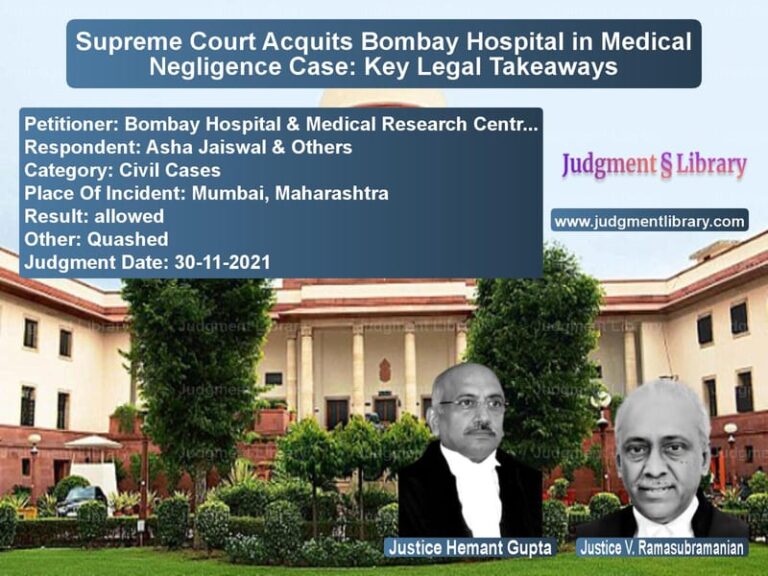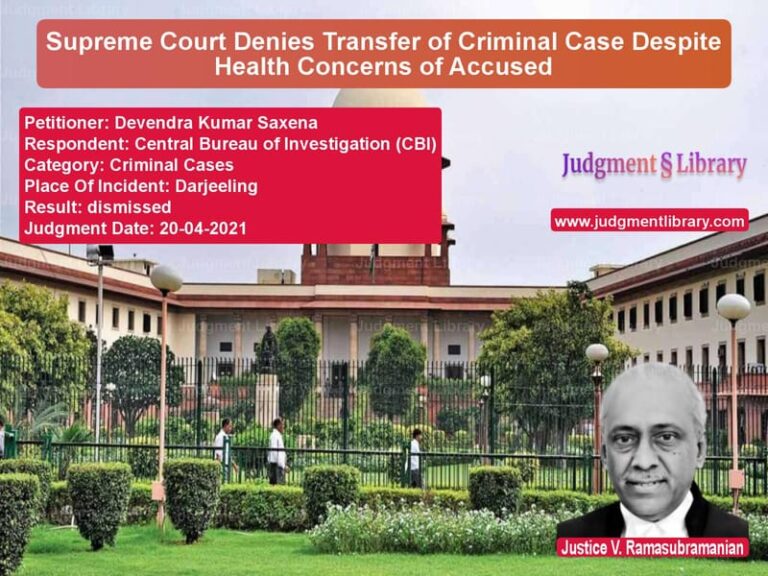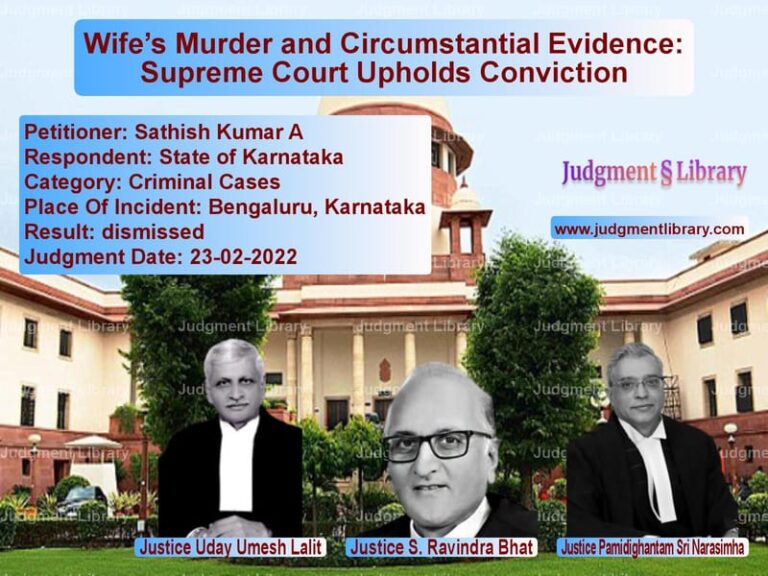Supreme Court Modifies Reinstatement Order, Awards Compensation in Labour Dispute
The Supreme Court of India, in the case of Ram Manohar Lohia Joint Hospital vs. Munna Prasad Saini, ruled on a significant labour dispute concerning the termination of a contractual employee. The Court set aside the Labour Court’s and High Court’s reinstatement order and instead awarded lump sum compensation to the worker. This judgment highlights key legal aspects regarding employment rights, termination procedures, and compensation under labour laws.
Background of the Case
The dispute arose when the first respondent, Munna Prasad Saini, claimed to have been wrongfully terminated from his job at Ram Manohar Lohia Joint Hospital in Lucknow. He asserted that he was employed as a ward boy from September 2003 to June 2005, but his employment was terminated without following due process. He subsequently approached the Labour Court seeking reinstatement and back wages.
The Labour Court, in its ruling dated January 20, 2010, held that the respondent was an employee of the appellant hospital, not a contract worker under Bombay Intelligence Security (I) Ltd., as claimed by the hospital. The court relied on:
- The hospital’s attendance records.
- The duty chart and salary payment register.
- Testimonies and documents obtained through the Right to Information Act.
Based on these findings, the Labour Court ordered the reinstatement of the respondent with compensation of Rs. 20,000 for the period of unemployment and full back wages from the date of the order.
High Court’s Ruling
The hospital challenged the Labour Court’s order before the Lucknow Bench of the High Court of Judicature at Allahabad. However, the High Court, in its decision dated November 15, 2018, upheld the Labour Court’s ruling, dismissing the hospital’s appeal.
Appeal Before the Supreme Court
Aggrieved by the High Court’s decision, Ram Manohar Lohia Joint Hospital and its administrators filed an appeal before the Supreme Court, arguing:
- The respondent was engaged as a contract worker through an external agency and was not a direct employee of the hospital.
- Reinstatement was not feasible, as the respondent’s employment was contractual and had ended in 2005.
- The Labour Court erred in holding that the respondent was a regular employee without considering relevant documentation.
Supreme Court’s Key Observations
1. Employer-Employee Relationship
The Supreme Court examined whether the respondent was a direct employee of the hospital. It noted:
“The Labour Court has relied on attendance registers, duty charts, and salary records, which support the claim that the respondent was directly engaged by the hospital.”
The Court thus upheld the finding that the respondent was an employee of the appellant hospital.
2. Contractual Nature of Employment
The Supreme Court acknowledged that the respondent’s employment was contractual. It observed:
“The first respondent was not a permanent employee but a contractual worker. His employment had ended in June 2005, and there is no record showing continuation beyond that period.”
3. Reinstatement Not Justified
The Court held that reinstatement was not an appropriate remedy, citing previous judgments that stated reinstatement should not be granted when a worker is employed on a contractual basis. The Court cited Bharat Sanchar Nigam Limited v. Bhurumal (2014) 7 SCC 177, which held:
“When the termination is found illegal due to a procedural defect, reinstatement with back wages is not automatic. Instead, monetary compensation should be granted.”
The Court ruled that the Labour Court and High Court had erred in ordering reinstatement, considering that the respondent had not worked at the hospital since 2005.
4. Compensation as an Alternative Remedy
The Court ruled that monetary compensation was a more appropriate remedy. It cited State of Uttarakhand v. Raj Kumar (2019) 14 SCC 353, which established that compensation should be granted in cases where reinstatement is impractical.
Considering the respondent’s work history and the lapse of time, the Court awarded a lump sum compensation of Rs. 10,00,000 (ten lakh rupees), to be paid within ten weeks.
Final Judgment
The Supreme Court ruled:
- The Labour Court’s and High Court’s reinstatement order was set aside.
- The respondent would receive a lump sum compensation of Rs. 10,00,000.
- The amount must be paid within ten weeks, failing which interest at 0.5% per month would be applicable.
Implications of the Judgment
This ruling has significant implications for labour law and contractual employment:
1. Protection for Contract Workers
The judgment underscores that contractual employees are entitled to legal protection against wrongful termination. Even if reinstatement is not granted, they can seek compensation.
2. Limitation on Reinstatement
The ruling clarifies that reinstatement is not an automatic remedy for wrongful termination, particularly when employment is contractual or for a fixed term.
3. Employer’s Responsibility in Disputes
The case highlights the importance of maintaining proper employment records. Employers cannot evade responsibility by claiming that a worker was hired through a contractor if evidence suggests direct engagement.
4. Compensation as a Practical Remedy
The Supreme Court’s decision aligns with modern labour law trends, emphasizing compensation as an effective remedy in cases where reinstatement is impractical.
Conclusion
The Supreme Court’s ruling in Ram Manohar Lohia Joint Hospital vs. Munna Prasad Saini strikes a balance between protecting workers’ rights and recognizing the practical limitations of reinstatement. The judgment reinforces that compensation, rather than reinstatement, is the preferred remedy in cases involving long-terminated employment. By awarding a substantial compensation, the Court ensures justice while maintaining judicial consistency in labour dispute resolutions.
Petitioner Name: Ram Manohar Lohia Joint Hospital.Respondent Name: Munna Prasad Saini.Judgment By: Justice R. Subhash Reddy, Justice Sanjiv Khanna.Place Of Incident: Lucknow, Uttar Pradesh.Judgment Date: 20-09-2021.
Don’t miss out on the full details! Download the complete judgment in PDF format below and gain valuable insights instantly!
Download Judgment: ram-manohar-lohia-jo-vs-munna-prasad-saini-supreme-court-of-india-judgment-dated-20-09-2021.pdf
Directly Download Judgment: Directly download this Judgment
See all petitions in Employment Disputes
See all petitions in Public Sector Employees
See all petitions in Recruitment Policies
See all petitions in Termination Cases
See all petitions in Judgment by R. Subhash Reddy
See all petitions in Judgment by Sanjiv Khanna
See all petitions in partially allowed
See all petitions in Modified
See all petitions in supreme court of India judgments September 2021
See all petitions in 2021 judgments
See all posts in Service Matters Category
See all allowed petitions in Service Matters Category
See all Dismissed petitions in Service Matters Category
See all partially allowed petitions in Service Matters Category






